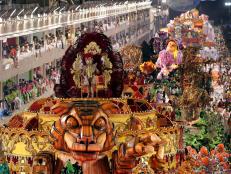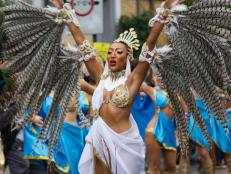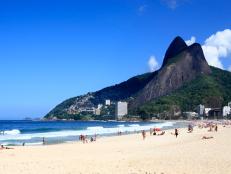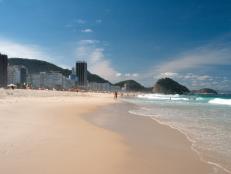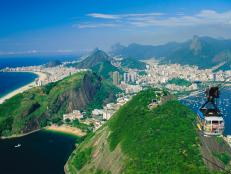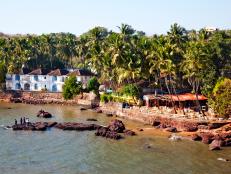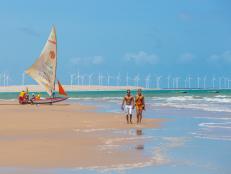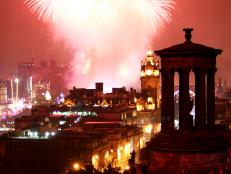Carnival in São Paulo

Thinkstock
Brazil celebrates the end of summer and the beginning of Lent every February or March, depending on the year, with a brash, flashy spectacle of song, dance and visual creativity called Carnival. Exuberant cheers and sparkling bits of glitter fill the night sky over the Sambadrome, São Paulo’s Carnival parade stadium, while thousands of revelers in colored feathers and dazzling tinsel march, twirl, sing and shout their way past boisterous crowds to the mesmerizing cadences of samba. The parades spring up every year throughout Brazil, featuring competing samba schools -- organized groups of participants united under an allegorical theme -- and despite the international popularity and singular intensity of Rio de Janeiro’s 2-night event, São Paulo has its own cadre of nationally known samba schools that can give a good show as well.
But Carnival in São Paulo isn’t just about the parades at the Sambadrome. Neighborhood associations throw roving, ragtag block parties called blocos that feature merrymakers in homemade costumes banging out rhythms on pots and pans from their own kitchens. And unlike in Rio, Sao Paulo does not get caught up in the madness. In Rio, anyone looking for a little peace and quiet heads out of town. Celebrations are relegated to certain sections of São Paulo, and those who wish to carry on their mundane business as usual need not flee the city. But who wants to miss out on the party?

São Paulo’s Carnival parade tradition only began in the 1970s. Participation in the event is often the province of the city’s working classes and die-hard partiers. Samba schools here attract big-name music and TV stars to perch atop their floats and recruit winning talent from among Rio’s most successful carnavalescos -- the creative masterminds behind every aspect of a school’s presentation.
The biggest parade event is the Grupo Especial, which sees the city’s top 14 samba schools compete in a 2-night extravaganza in São Paulo’s Sambadrome. The event is broadcast nationally on the Saturday and Sunday of Carnival so as not to distract from Rio’s Grupo Especial parades on Monday and Tuesday. (Yes, each city commands the country’s undivided attention.)
São Paulo’s Sambadrome, officially the Sambodromo do Anhembi, opened in 1991 and holds up to 30,000 spectators. During the parades, the samba schools are judged in several categories -- including theme, costumes and overall organizations -- during their 45-minute pass through the stadium. Themes in years past have included a century of Japanese immigration to Brazil and the deliciousness of chocolate. Mocidade Alegre, last year’s winner, created a theme that paid homage to popular Brazilian writer Jorge Amado.
The champion samba school’s song becomes a nationwide hit, and it’s played throughout the year. (The lowest-scoring school gets relegated to the minor league Grupo de Acesso, which has its parade the Sunday after the main event.) Mocidade Alegre, Vai-Vai, Academicos do Tucuruvi, Rosas de Ouro and Unidos de Vila Maria are a few of the big players and crowd favorites in the Grupo Especial.

Anyone interested in participating in the parades, even tourists just passing through for the event, should contact the Sao Paulo Samba School League or each school individually. Tickets to watch the event can be purchased in person at the Sambadrome, or online (with a Brazilian ID), and cost from R$25 to $150, depending on the date and the parade you wish to see. More expensive private booths (seating up to 25 people) can go for as much as R$30,000.
Blocos, Always Boisterous
Blocos are often spontaneous, always boisterous bands of revelers literally marching to the beat of their own drums -- or oversized mobile stereos blasting rock and pop. They represent the whimsically democratic Carnival spirit in which anyone can participate, from rump-shakers in carefully pieced-together costumes to working stiffs escaping the office in suit and tie. In fact, the Sambadrome’s elaborate and highly organized samba schools evolved from these little slapdash affairs that traipse up and down local streets, often collecting bystanders and pulling them in to the fun.
During the entire 5-day Carnival period, there will be a bloco or 2 parading through São Paulo. Some of the best-known include Academicos do Baixo Augusta, the official party people of the city’s funkiest entertainment district, and the hilarious Vai Quem Que, which prances raucously around the São Paulo district of Pinheiros -- the Vila Madalena neighborhood, specifically. Downtown, Cordao Cecilia brings a bit of Afro-Brazilian flow from Brazil’s northeast, while Bloco dos Esfarrapados keeps it old school in the Bixiga district -- this bloco was founded way back in 1947.
São Paulo’s Carnival Balls
Whether elegant or erotic, Carnival balls tie São Paulo’s traditions to those of Venice with face masks and a privileged atmosphere. The most exclusive balls are invitation-only, limited to the well-heeled and the well-connected. Many restaurants and nightclubs, however, keep the ball tradition alive by encouraging their patrons to don costumes and celebrate Carnival in a more laid-back environment. Bar Brahma and Havana Club offer live samba and plenty of adult beverages for more mature crowds, while mega-club The Week throws the biggest Carnival party on the gay and lesbian circuit. Cover charges usually run R$50 to $80.
